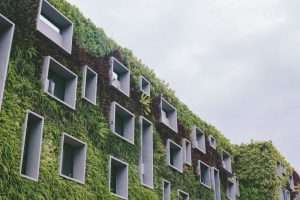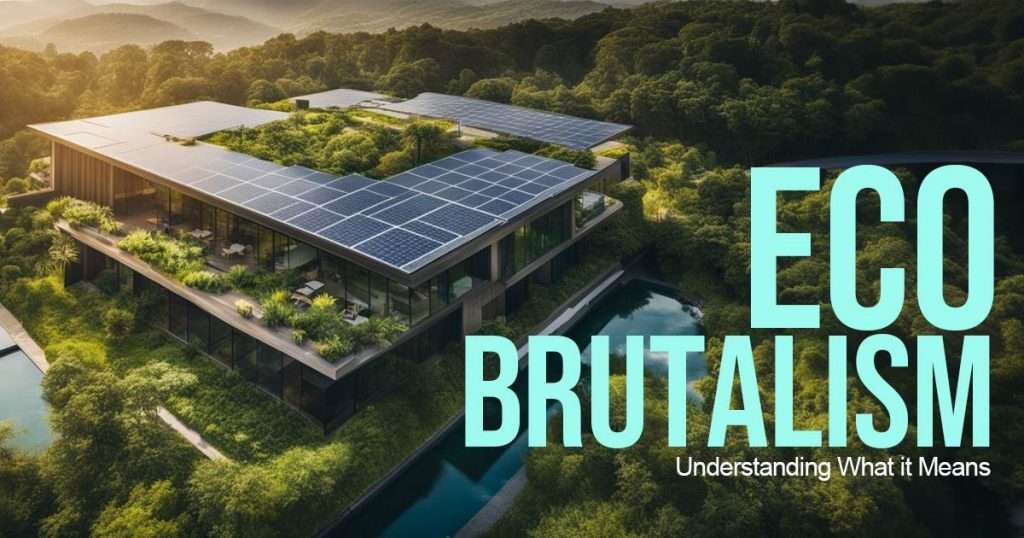Eco-brutalism mixes eco-friendly ideas with the strong look of brutalist buildings. Brutalism started in the middle of the 20th century, using raw concrete and simple shapes. Eco-brutalism adds green ideas to this style, caring about the environment.
How does eco-brutalism work?
eco-brutalism is all about living with nature, not ruling over it. Here’s how it does that:
- Material Choice: Architects who follow eco-brutalism pick eco-friendly materials like recycled wood and steel. They also use alternatives to concrete that are better for the environment. By choosing these materials, they help cut down on waste and save natural resources.
- Adding Greenery: Unlike regular brutalist buildings, eco-brutalism designs include lots of green spaces. They have gardens on rooftops, walls covered in plants, and shared green areas. These not only soften the harsh look of concrete but also give homes to city animals and plants. They’re like little nature spots in the city.
- Saving Energy: eco-brutalism is big on using energy wisely. They use special materials to keep buildings warm or cool, like good insulation. They also use solar panels and smart systems to use less electricity. By using these green technologies, they cut down on pollution and help fight climate change.
- Using Water Wisely: Managing water well is super important in eco-brutalism. They collect rainwater, use efficient plumbing, and treat water on-site. This helps save water and eases the pressure on city water supplies.
Basically, eco-brutalism shows us that we can build cool-looking buildings without hurting the planet. By picking the right materials, adding green spaces, saving energy, and using water smartly, eco-brutalism makes our cities greener and stronger, while still looking awesome.
Is eco-brutalism bad for the environment?
But eco-brutalism isn’t perfect. Here are a few things to think about:
- Concrete’s Carbon Footprint: Concrete, a big part of eco-brutalist buildings, isn’t so great for the environment. Making cement, one of its main ingredients releases a lot of greenhouse gases, which contribute to climate change. So, using a lot of concrete in eco-brutalist buildings can actually harm the environment and make global warming worse.
- Balancing Looks and Greenness: It’s tough to make eco-brutalist buildings both look cool and good for the Earth. Architects have to juggle making buildings that stand out and making them eco-friendly. Sometimes, they have to choose between making a building look awesome and making it good for the environment.
- Watch Out for Fake Green Stuff: Some buildings claim to be eco-brutalist but don’t do much for the environment. They might add a few green features just to look good, without really helping the planet. It’s important to make sure that eco-brutalist buildings are truly green and not just pretending to be.
So, while eco-brutalism has its perks, it’s also got its problems. It’s up to architects and builders to make sure that eco-brutalist buildings really do help the Earth.

Is it expensive to implement eco-brutalism?
Using eco-brutalism in building design might cost more at the beginning, but it can save money in the long run. Here’s how:
- Higher Initial Costs: At first, choosing eco-friendly materials and technologies might be more expensive than regular ones. Things like recycled steel and special insulation can cost more upfront. Also, setting up energy-efficient systems, like solar panels, requires extra money to buy and install them.
- Long-Term Savings: Even though it costs more to start with, eco-brutalism can save money over time. Energy-efficient stuff, such as solar panels and good insulation, can cut down on electricity bills for heating, cooling, and power. Water-saving systems also help to reduce water bills, saving more money in the long term.
- Return on Investment: The return on investment, or ROI, for eco-brutalism projects, depends on a few things, like how big the project is and where it’s located. While it might cost a lot to begin with, the money saved on energy and water bills can make up for it over the years. Plus, buildings designed with eco-brutalism in mind can be worth more, making them a smart investment.
- Keeping Costs Down: Architects and builders can find ways to make eco-brutalism more affordable without sacrificing eco-friendliness. They can design buildings to use natural sunlight and wind for heating and cooling, use materials from nearby places to save on transportation costs, and use low-maintenance landscaping to save on upkeep. Plus, they can take advantage of government incentives and grants to help cover the initial costs and make it more affordable.
Should you consider eco-brutalism?
Deciding whether to go for eco-brutalism in architecture involves looking at a few important things. While it offers cool ways to build sustainably, it’s important to think about everything it involves.
- Helping the Environment: When thinking about eco-brutalism, we need to think about how it affects the environment. Architects and designers need to pick materials and designs that are good for the planet. Using eco-friendly stuff can help make buildings that don’t harm the environment too much.
- Making it Look Good: Even though being eco-friendly is important, buildings also need to look nice. Architects have to find a balance between the cool, tough look of brutalism and making sure the building is good for the environment too. It’s a challenge to make buildings that look awesome and are eco-friendly at the same time.
- Thinking About Costs: Another big thing to think about is how much it costs to use eco-brutalism. Sometimes, using sustainable stuff can be more expensive at first. But in the long run, it can save money and be better for the environment. Architects need to find ways to make it affordable without giving up on being eco-friendly.
- Following the Rules: Eco-brutalist buildings need to follow all the rules and regulations. They have to meet standards for things like saving energy, being eco-friendly, and keeping people safe. If they meet all the rules, they can get recognized as eco-friendly buildings.
- Impact on the Community: Architects also need to think about how their buildings affect the people around them. They need to make sure their designs fit in with the neighborhood, make public spaces better, and help the community. Getting input from the community can help make sure everyone likes the final building.
- Thinking Long-Term: When thinking about eco-brutalism, architects need to think about the future too. The choices they make now will affect things for a long time, like how much stuff gets used and how the building can handle different things in the future. Making buildings that last a long time and are good for the environment is important.
While eco-brutalism offers an exciting path to sustainable architecture, architects must balance its unique aesthetic with a careful assessment of environmental impact, cost, regulations, community benefits, and long-term viability. This holistic approach leads to successful eco-brutalist projects.

Understanding What eco-brutalism Is
Eco-brutalism is a cool mix of being good for the environment and having awesome building designs. It can help protect nature and make cities more diverse, but it also has some problems like making too much pollution when making concrete and pretending to be eco-friendly without really being. Architects need to think hard about how to make eco-brutalist projects work well and find new ways to make them even better for the planet.

